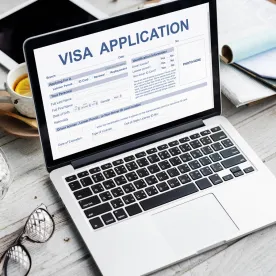In a period of fluctuating immigration policies, the question of how to secure a permanent foothold in the U.S. takes on greater urgency. This article outlines the lawful permanent resident process and issues.
Individuals seeking permanent resident status (a “green card”) in the United States who do not have a close U.S. citizen or legal permanent resident relative will most likely need employer sponsorship. Exceptions exist for asylum seekers, diversity lottery winners, major investors, and ministers, among others. There are three steps in the usual process to obtain a green card through employer sponsorship: (1) labor certification, now known as “PERM;” (2) visa petition (Form I-140); and (3) Adjustment of Status (“AOS”) to become a permanent resident through a U.S. Citizenship and Immigration Service (“USCIS”) office, or consular processing at a U.S. embassy or consulate overseas.
Labor Certification (“PERM”)
The first step, labor certification, requires employers to prove that there are no American workers qualified or available to do the job. To make this proof, the employer must advertise the position, list the position with the State job bank, and post a notice disclosing the position, title, and salary to other employees or unions at the workplace. The employer must also pay a salary that the U.S. Labor Department deems comparable to the average wage paid for this type of position in the area. The PERM may be approved in a few months or could take years if subject to an audit.
Visa Petition (I-140)
Once the PERM labor certification is certified, the employer can apply for immigrant visa (“green card”) classification on the employee's behalf by filing Form I-140 with USCIS. The visa petition seeks classification in one of several employment-based (“EB”) categories. On this form, the employer must describe the business, the position, and the employee's qualifications, proving “ability to pay the required wage” and that the minimum job requirements, as stated on the PERM at the date of hire, were satisfied.
It usually takes three to six months to obtain approval of a visa petition from USCIS, but Premium Processing is available in most cases to obtain a response in 15 days or less. If the employee has a spouse and/or minor children, they may obtain green cards with the employee as his/her dependents, and are identified on the I-140 filing.
Quota Delays
Depending upon which classification is sought and where the employee was born, an immigrant visa/green card may be immediately available, or there may be a delay of several years before a visa is available. These delays are caused by quotas assigned to the various visa classifications and countries of origin.
The “EB-2” category is for advanced degree holders, meaning that the employee must have both a Bachelor’s degree and at least five years of progressive experience, or an advanced degree, and will be employed in a job that requires an advance degree.
The “EB-3” category is for skilled workers, professionals, and other workers. Skilled workers are defined as those with at least two years’ training or experience, including foreign nationals holding two-year Associate’s degrees. A professional is defined as someone holding a Bachelor’s degree or its foreign equivalent. The “Other Worker” sub-category of the EB-3 classification encompasses unskilled workers.
There are currently backlogs in the EB-2 and EB-3 categories for certain countries. Visa availability is determined by the U.S. State Department each month and published in the Visa Bulletin. The filing date of the PERM labor certification establishes the “priority date” and is the employee's place-holder in the green card quota backlog. When the priority date is either current or before the cut-off date for the employee's country of birth (or his/her spouse’s country of birth) in the Visa Bulletin, the third step of the green card process may be completed: AOS or consular processing to become a Legal Permanent Resident.
Adjustment of Status and Consular Processing
After or concurrently with I-140 approval, depending on the Priority Date and country of birth, the third step of the process may be completed. The priority date as described above must be current, as stated in the State Department Visa Bulletin, in order to permit filing of the AOS application. AOS is initiated by filing Form I-485 and supplemental forms with a USCIS office. This form requires the employee's biographical, health, and other personal information, and confirms past compliance with U.S. immigration rules.
Permanent residency may also be obtained through a U.S. consular office in the employee's home country by completing Form DS-260. The consular office will conduct an interview, medical exam, and investigation of the employee's past that is very similar to the USCIS AOS process. The forms and procedures, however, are different because the U.S. consular offices are under the jurisdiction of the State Department, not USCIS.
Avoiding Labor Certification and/or Quota Delays
There are several ways to avoid or decrease the burden of labor certification and also avoid long quota delays. For example, three types of workers, together referred to as “priority workers,” are totally exempt from the labor certification requirement. These are foreign nationals of “extraordinary ability,” “outstanding professors and researchers” who have at least three years full-time teaching experience and a full-time tenure track offer in the United States, and certain executives and managers of multinational corporations. Priority workers are classified in the EB-1 category, where immigrant visa numbers are currently available for all countries.
Another way of avoiding labor certification is by proving that the employee's continued employment in the United States is in the “national interest” of the United States. This proof is made by showing that his/her employment benefits the economy, national health care system, educational system, or other high-priority federal interest. “National Interest Waiver” petitions are classified in the EB-2 category, where quota delays are shorter than the EB-3 category for all foreign nationals.
Furthermore, nurses and physical therapists and foreign nationals possessing “exceptional ability in the arts or sciences” are eligible for an exemption from labor certification called “Schedule A.” College and university professors and foreign nationals possessing “exceptional ability in the performing arts” are eligible for a reduced form of labor certification called “Special Handling.”
Conclusion
From start to finish, obtaining a green card can take approximately from 12 months to more than a decade, especially if the visa category is subject to a quota backlog. During this time, the employee can usually travel freely, unless he/she is subject to a restriction. The employee must also remain employed with the employer-sponsor through most of the process. In addition to being time-consuming, obtaining a green card is expensive.
Having obtained a green card, the employee has most of the same rights and obligations as U.S. citizens. For example, he/she must pay U.S. income taxes on your worldwide income and is eligible for some government benefits. However, the employee cannot vote. Most significantly, he/she is subject to the “abandonment of residency” rules, meaning that the employee may lose his/her green card if he/she is absent from the U.S. for an extended period of time. In order to become a naturalized U.S. citizen, an individual usually must hold a green card for five years and physically reside in the U.S. for at least half that time.
While obtaining permanent resident status based on a job in the U.S. can take a substantial amount of time and money, there are numerous advantages of permanent resident status. By obtaining a green card, the ability to travel, seek employment and/or relocate is greatly enhanced.




 />i
/>i

